Financial Management: Risk in Financial Decision Making
VerifiedAdded on 2022/08/14
|17
|3422
|78
Report
AI Summary
This report delves into the critical area of financial management, specifically focusing on business risk in financial decision-making. It begins with an introduction to financial management, emphasizing its role in planning, organizing, and controlling financial resources to achieve organizational objectives. The report then provides a comprehensive literature review of risk management, including the identification, analysis, and mitigation of uncertainty in investment decisions. It explores various techniques for managing risk, such as diversification and the use of financial instruments like futures and options. The core of the report examines techniques for mitigating risk in capital budgeting, including sensitivity analysis, scenario planning (Monte Carlo simulation), risk-adjusted discount rates, and probability analysis. Each technique is explained in detail, with examples and discussions of their advantages and limitations. The report highlights the importance of risk adjustment in capital budgeting to ensure that returns are proportionate to the risks borne. It concludes by emphasizing the significance of effective risk management in achieving business objectives and the need for companies to proactively identify and address various types of risks, including strategic, compliance, financial, and operational risks.
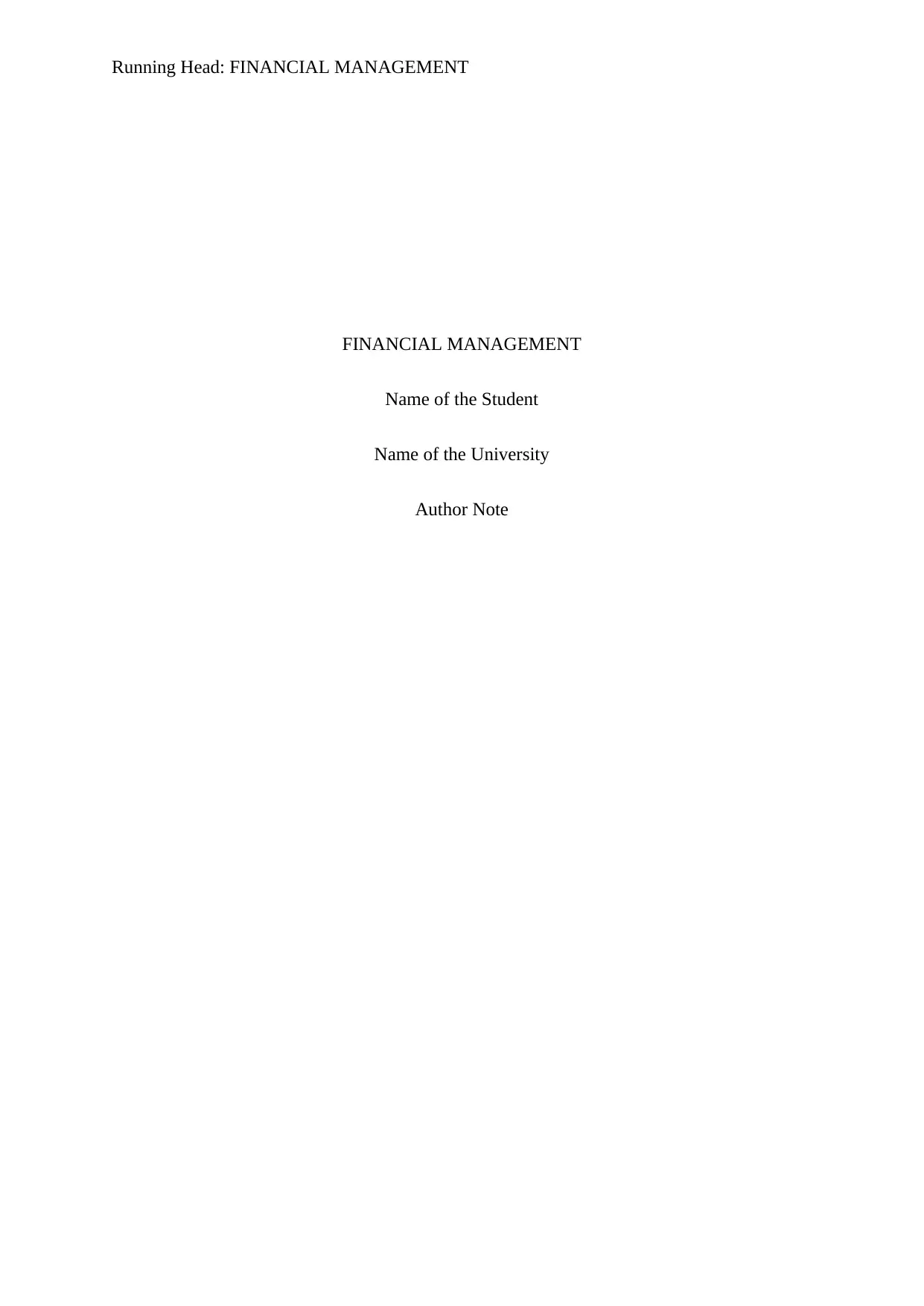
Running Head: FINANCIAL MANAGEMENT
FINANCIAL MANAGEMENT
Name of the Student
Name of the University
Author Note
FINANCIAL MANAGEMENT
Name of the Student
Name of the University
Author Note
Paraphrase This Document
Need a fresh take? Get an instant paraphrase of this document with our AI Paraphraser
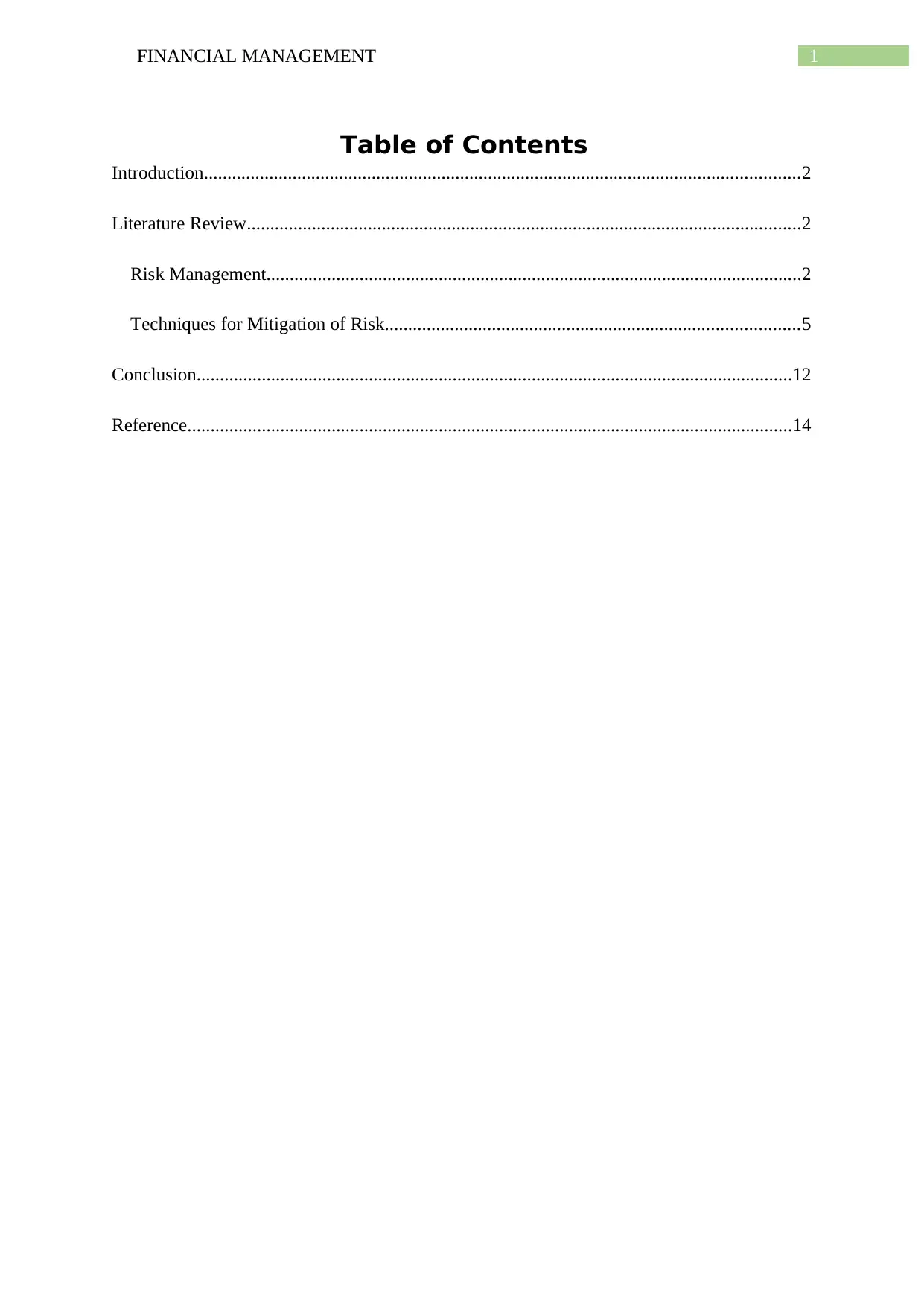
1FINANCIAL MANAGEMENT
Table of Contents
Introduction................................................................................................................................2
Literature Review.......................................................................................................................2
Risk Management...................................................................................................................2
Techniques for Mitigation of Risk.........................................................................................5
Conclusion................................................................................................................................12
Reference..................................................................................................................................14
Table of Contents
Introduction................................................................................................................................2
Literature Review.......................................................................................................................2
Risk Management...................................................................................................................2
Techniques for Mitigation of Risk.........................................................................................5
Conclusion................................................................................................................................12
Reference..................................................................................................................................14
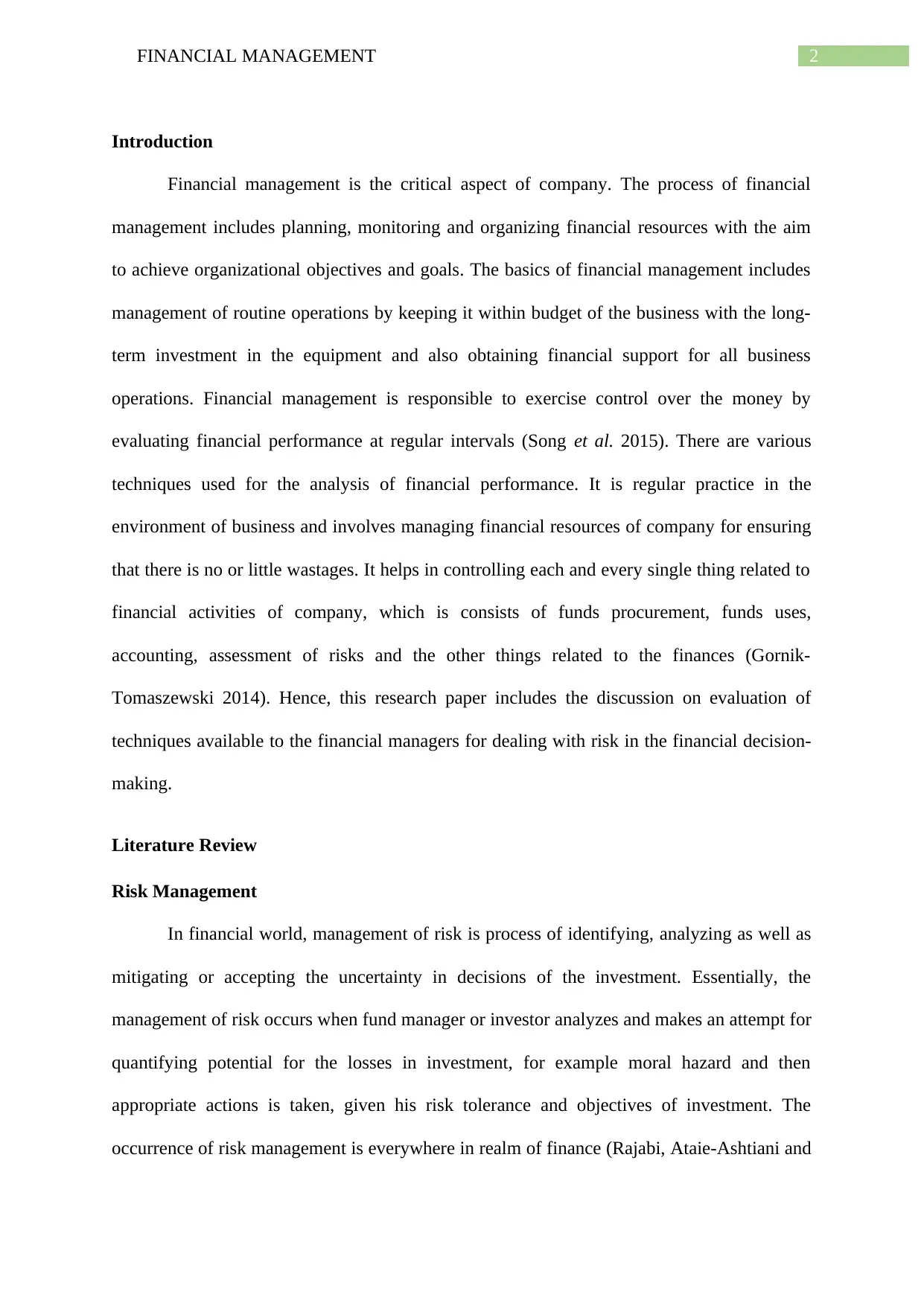
2FINANCIAL MANAGEMENT
Introduction
Financial management is the critical aspect of company. The process of financial
management includes planning, monitoring and organizing financial resources with the aim
to achieve organizational objectives and goals. The basics of financial management includes
management of routine operations by keeping it within budget of the business with the long-
term investment in the equipment and also obtaining financial support for all business
operations. Financial management is responsible to exercise control over the money by
evaluating financial performance at regular intervals (Song et al. 2015). There are various
techniques used for the analysis of financial performance. It is regular practice in the
environment of business and involves managing financial resources of company for ensuring
that there is no or little wastages. It helps in controlling each and every single thing related to
financial activities of company, which is consists of funds procurement, funds uses,
accounting, assessment of risks and the other things related to the finances (Gornik-
Tomaszewski 2014). Hence, this research paper includes the discussion on evaluation of
techniques available to the financial managers for dealing with risk in the financial decision-
making.
Literature Review
Risk Management
In financial world, management of risk is process of identifying, analyzing as well as
mitigating or accepting the uncertainty in decisions of the investment. Essentially, the
management of risk occurs when fund manager or investor analyzes and makes an attempt for
quantifying potential for the losses in investment, for example moral hazard and then
appropriate actions is taken, given his risk tolerance and objectives of investment. The
occurrence of risk management is everywhere in realm of finance (Rajabi, Ataie-Ashtiani and
Introduction
Financial management is the critical aspect of company. The process of financial
management includes planning, monitoring and organizing financial resources with the aim
to achieve organizational objectives and goals. The basics of financial management includes
management of routine operations by keeping it within budget of the business with the long-
term investment in the equipment and also obtaining financial support for all business
operations. Financial management is responsible to exercise control over the money by
evaluating financial performance at regular intervals (Song et al. 2015). There are various
techniques used for the analysis of financial performance. It is regular practice in the
environment of business and involves managing financial resources of company for ensuring
that there is no or little wastages. It helps in controlling each and every single thing related to
financial activities of company, which is consists of funds procurement, funds uses,
accounting, assessment of risks and the other things related to the finances (Gornik-
Tomaszewski 2014). Hence, this research paper includes the discussion on evaluation of
techniques available to the financial managers for dealing with risk in the financial decision-
making.
Literature Review
Risk Management
In financial world, management of risk is process of identifying, analyzing as well as
mitigating or accepting the uncertainty in decisions of the investment. Essentially, the
management of risk occurs when fund manager or investor analyzes and makes an attempt for
quantifying potential for the losses in investment, for example moral hazard and then
appropriate actions is taken, given his risk tolerance and objectives of investment. The
occurrence of risk management is everywhere in realm of finance (Rajabi, Ataie-Ashtiani and
⊘ This is a preview!⊘
Do you want full access?
Subscribe today to unlock all pages.

Trusted by 1+ million students worldwide
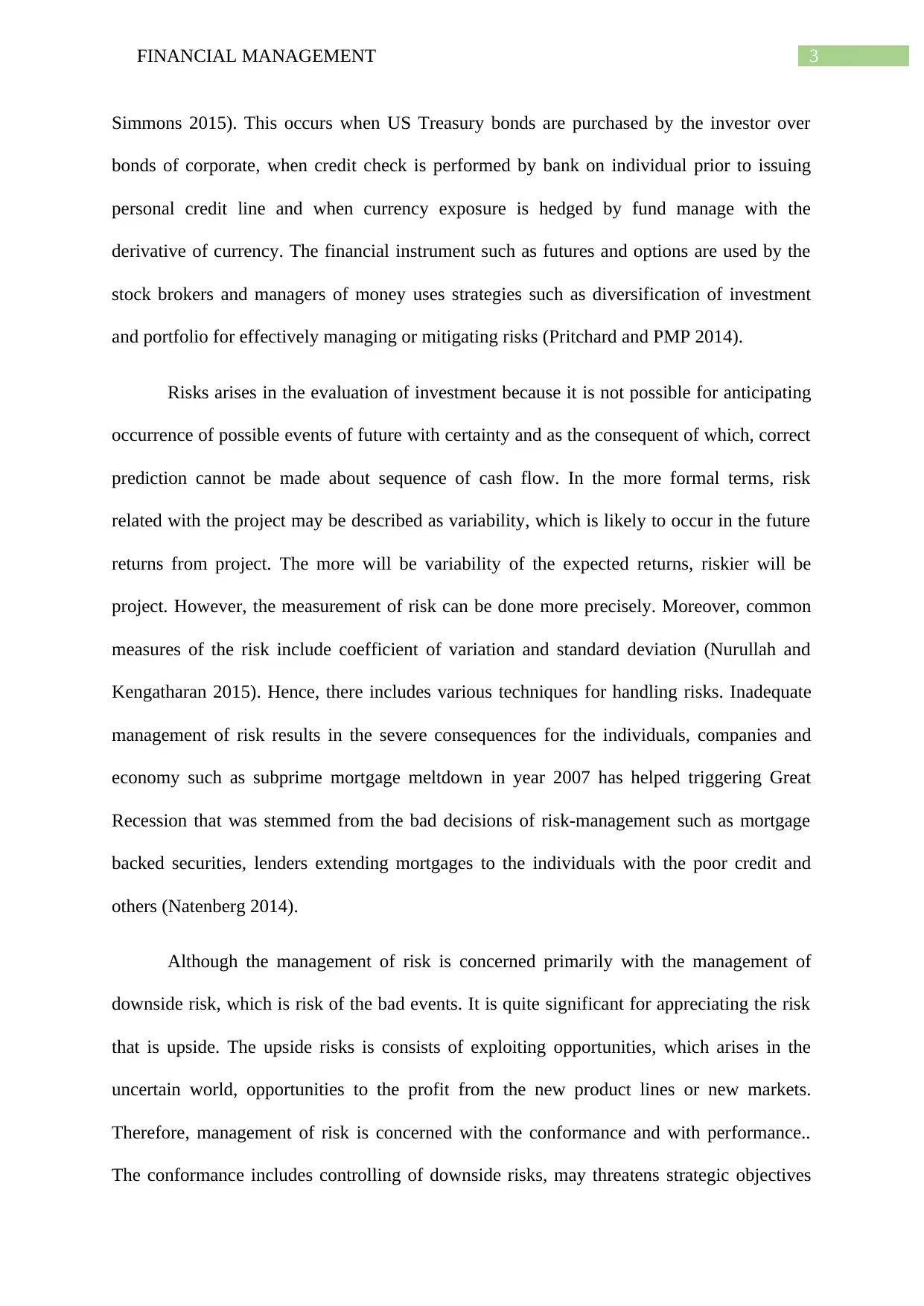
3FINANCIAL MANAGEMENT
Simmons 2015). This occurs when US Treasury bonds are purchased by the investor over
bonds of corporate, when credit check is performed by bank on individual prior to issuing
personal credit line and when currency exposure is hedged by fund manage with the
derivative of currency. The financial instrument such as futures and options are used by the
stock brokers and managers of money uses strategies such as diversification of investment
and portfolio for effectively managing or mitigating risks (Pritchard and PMP 2014).
Risks arises in the evaluation of investment because it is not possible for anticipating
occurrence of possible events of future with certainty and as the consequent of which, correct
prediction cannot be made about sequence of cash flow. In the more formal terms, risk
related with the project may be described as variability, which is likely to occur in the future
returns from project. The more will be variability of the expected returns, riskier will be
project. However, the measurement of risk can be done more precisely. Moreover, common
measures of the risk include coefficient of variation and standard deviation (Nurullah and
Kengatharan 2015). Hence, there includes various techniques for handling risks. Inadequate
management of risk results in the severe consequences for the individuals, companies and
economy such as subprime mortgage meltdown in year 2007 has helped triggering Great
Recession that was stemmed from the bad decisions of risk-management such as mortgage
backed securities, lenders extending mortgages to the individuals with the poor credit and
others (Natenberg 2014).
Although the management of risk is concerned primarily with the management of
downside risk, which is risk of the bad events. It is quite significant for appreciating the risk
that is upside. The upside risks is consists of exploiting opportunities, which arises in the
uncertain world, opportunities to the profit from the new product lines or new markets.
Therefore, management of risk is concerned with the conformance and with performance..
The conformance includes controlling of downside risks, may threatens strategic objectives
Simmons 2015). This occurs when US Treasury bonds are purchased by the investor over
bonds of corporate, when credit check is performed by bank on individual prior to issuing
personal credit line and when currency exposure is hedged by fund manage with the
derivative of currency. The financial instrument such as futures and options are used by the
stock brokers and managers of money uses strategies such as diversification of investment
and portfolio for effectively managing or mitigating risks (Pritchard and PMP 2014).
Risks arises in the evaluation of investment because it is not possible for anticipating
occurrence of possible events of future with certainty and as the consequent of which, correct
prediction cannot be made about sequence of cash flow. In the more formal terms, risk
related with the project may be described as variability, which is likely to occur in the future
returns from project. The more will be variability of the expected returns, riskier will be
project. However, the measurement of risk can be done more precisely. Moreover, common
measures of the risk include coefficient of variation and standard deviation (Nurullah and
Kengatharan 2015). Hence, there includes various techniques for handling risks. Inadequate
management of risk results in the severe consequences for the individuals, companies and
economy such as subprime mortgage meltdown in year 2007 has helped triggering Great
Recession that was stemmed from the bad decisions of risk-management such as mortgage
backed securities, lenders extending mortgages to the individuals with the poor credit and
others (Natenberg 2014).
Although the management of risk is concerned primarily with the management of
downside risk, which is risk of the bad events. It is quite significant for appreciating the risk
that is upside. The upside risks is consists of exploiting opportunities, which arises in the
uncertain world, opportunities to the profit from the new product lines or new markets.
Therefore, management of risk is concerned with the conformance and with performance..
The conformance includes controlling of downside risks, may threatens strategic objectives
Paraphrase This Document
Need a fresh take? Get an instant paraphrase of this document with our AI Paraphraser
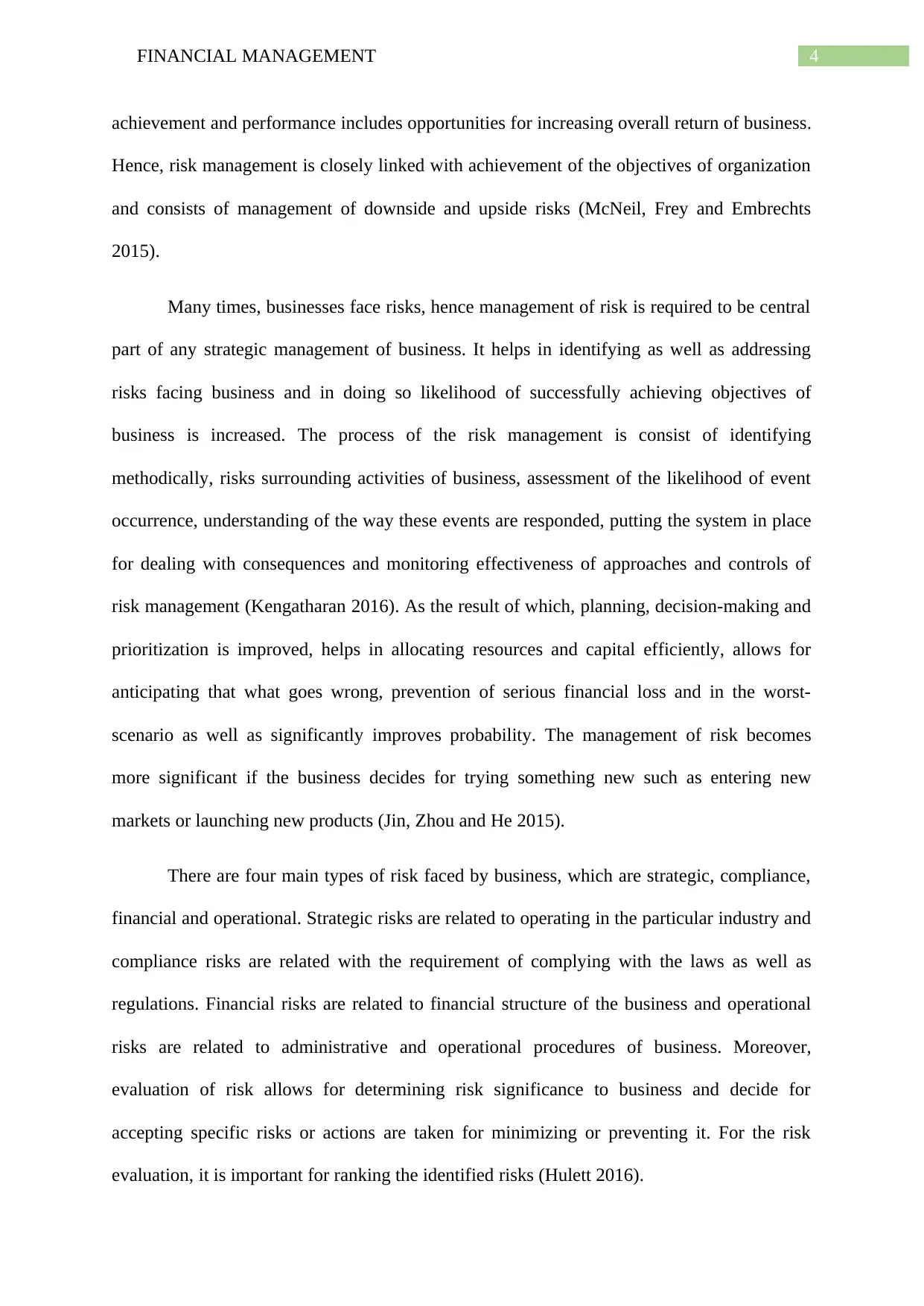
4FINANCIAL MANAGEMENT
achievement and performance includes opportunities for increasing overall return of business.
Hence, risk management is closely linked with achievement of the objectives of organization
and consists of management of downside and upside risks (McNeil, Frey and Embrechts
2015).
Many times, businesses face risks, hence management of risk is required to be central
part of any strategic management of business. It helps in identifying as well as addressing
risks facing business and in doing so likelihood of successfully achieving objectives of
business is increased. The process of the risk management is consist of identifying
methodically, risks surrounding activities of business, assessment of the likelihood of event
occurrence, understanding of the way these events are responded, putting the system in place
for dealing with consequences and monitoring effectiveness of approaches and controls of
risk management (Kengatharan 2016). As the result of which, planning, decision-making and
prioritization is improved, helps in allocating resources and capital efficiently, allows for
anticipating that what goes wrong, prevention of serious financial loss and in the worst-
scenario as well as significantly improves probability. The management of risk becomes
more significant if the business decides for trying something new such as entering new
markets or launching new products (Jin, Zhou and He 2015).
There are four main types of risk faced by business, which are strategic, compliance,
financial and operational. Strategic risks are related to operating in the particular industry and
compliance risks are related with the requirement of complying with the laws as well as
regulations. Financial risks are related to financial structure of the business and operational
risks are related to administrative and operational procedures of business. Moreover,
evaluation of risk allows for determining risk significance to business and decide for
accepting specific risks or actions are taken for minimizing or preventing it. For the risk
evaluation, it is important for ranking the identified risks (Hulett 2016).
achievement and performance includes opportunities for increasing overall return of business.
Hence, risk management is closely linked with achievement of the objectives of organization
and consists of management of downside and upside risks (McNeil, Frey and Embrechts
2015).
Many times, businesses face risks, hence management of risk is required to be central
part of any strategic management of business. It helps in identifying as well as addressing
risks facing business and in doing so likelihood of successfully achieving objectives of
business is increased. The process of the risk management is consist of identifying
methodically, risks surrounding activities of business, assessment of the likelihood of event
occurrence, understanding of the way these events are responded, putting the system in place
for dealing with consequences and monitoring effectiveness of approaches and controls of
risk management (Kengatharan 2016). As the result of which, planning, decision-making and
prioritization is improved, helps in allocating resources and capital efficiently, allows for
anticipating that what goes wrong, prevention of serious financial loss and in the worst-
scenario as well as significantly improves probability. The management of risk becomes
more significant if the business decides for trying something new such as entering new
markets or launching new products (Jin, Zhou and He 2015).
There are four main types of risk faced by business, which are strategic, compliance,
financial and operational. Strategic risks are related to operating in the particular industry and
compliance risks are related with the requirement of complying with the laws as well as
regulations. Financial risks are related to financial structure of the business and operational
risks are related to administrative and operational procedures of business. Moreover,
evaluation of risk allows for determining risk significance to business and decide for
accepting specific risks or actions are taken for minimizing or preventing it. For the risk
evaluation, it is important for ranking the identified risks (Hulett 2016).
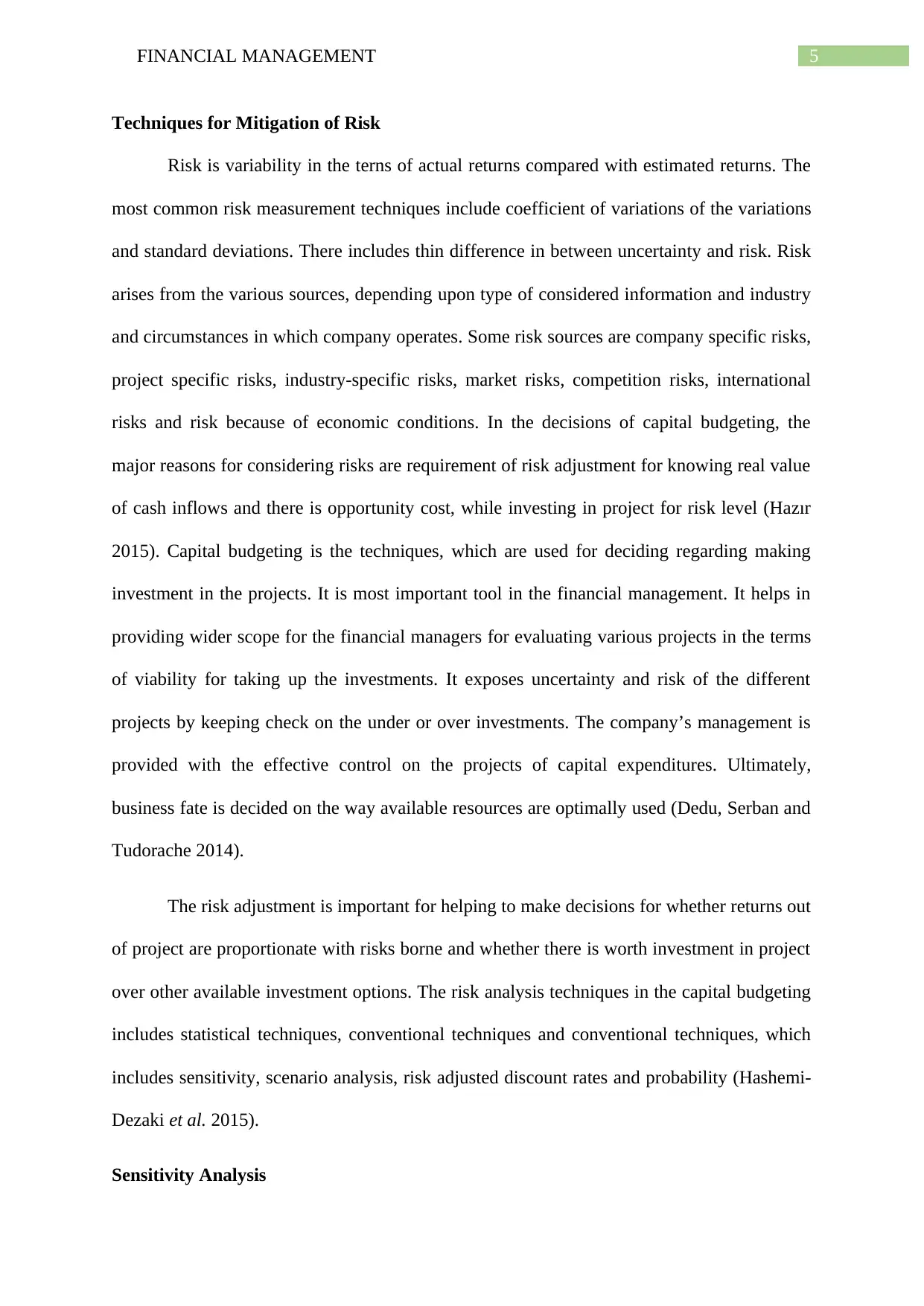
5FINANCIAL MANAGEMENT
Techniques for Mitigation of Risk
Risk is variability in the terns of actual returns compared with estimated returns. The
most common risk measurement techniques include coefficient of variations of the variations
and standard deviations. There includes thin difference in between uncertainty and risk. Risk
arises from the various sources, depending upon type of considered information and industry
and circumstances in which company operates. Some risk sources are company specific risks,
project specific risks, industry-specific risks, market risks, competition risks, international
risks and risk because of economic conditions. In the decisions of capital budgeting, the
major reasons for considering risks are requirement of risk adjustment for knowing real value
of cash inflows and there is opportunity cost, while investing in project for risk level (Hazır
2015). Capital budgeting is the techniques, which are used for deciding regarding making
investment in the projects. It is most important tool in the financial management. It helps in
providing wider scope for the financial managers for evaluating various projects in the terms
of viability for taking up the investments. It exposes uncertainty and risk of the different
projects by keeping check on the under or over investments. The company’s management is
provided with the effective control on the projects of capital expenditures. Ultimately,
business fate is decided on the way available resources are optimally used (Dedu, Serban and
Tudorache 2014).
The risk adjustment is important for helping to make decisions for whether returns out
of project are proportionate with risks borne and whether there is worth investment in project
over other available investment options. The risk analysis techniques in the capital budgeting
includes statistical techniques, conventional techniques and conventional techniques, which
includes sensitivity, scenario analysis, risk adjusted discount rates and probability (Hashemi-
Dezaki et al. 2015).
Sensitivity Analysis
Techniques for Mitigation of Risk
Risk is variability in the terns of actual returns compared with estimated returns. The
most common risk measurement techniques include coefficient of variations of the variations
and standard deviations. There includes thin difference in between uncertainty and risk. Risk
arises from the various sources, depending upon type of considered information and industry
and circumstances in which company operates. Some risk sources are company specific risks,
project specific risks, industry-specific risks, market risks, competition risks, international
risks and risk because of economic conditions. In the decisions of capital budgeting, the
major reasons for considering risks are requirement of risk adjustment for knowing real value
of cash inflows and there is opportunity cost, while investing in project for risk level (Hazır
2015). Capital budgeting is the techniques, which are used for deciding regarding making
investment in the projects. It is most important tool in the financial management. It helps in
providing wider scope for the financial managers for evaluating various projects in the terms
of viability for taking up the investments. It exposes uncertainty and risk of the different
projects by keeping check on the under or over investments. The company’s management is
provided with the effective control on the projects of capital expenditures. Ultimately,
business fate is decided on the way available resources are optimally used (Dedu, Serban and
Tudorache 2014).
The risk adjustment is important for helping to make decisions for whether returns out
of project are proportionate with risks borne and whether there is worth investment in project
over other available investment options. The risk analysis techniques in the capital budgeting
includes statistical techniques, conventional techniques and conventional techniques, which
includes sensitivity, scenario analysis, risk adjusted discount rates and probability (Hashemi-
Dezaki et al. 2015).
Sensitivity Analysis
⊘ This is a preview!⊘
Do you want full access?
Subscribe today to unlock all pages.

Trusted by 1+ million students worldwide
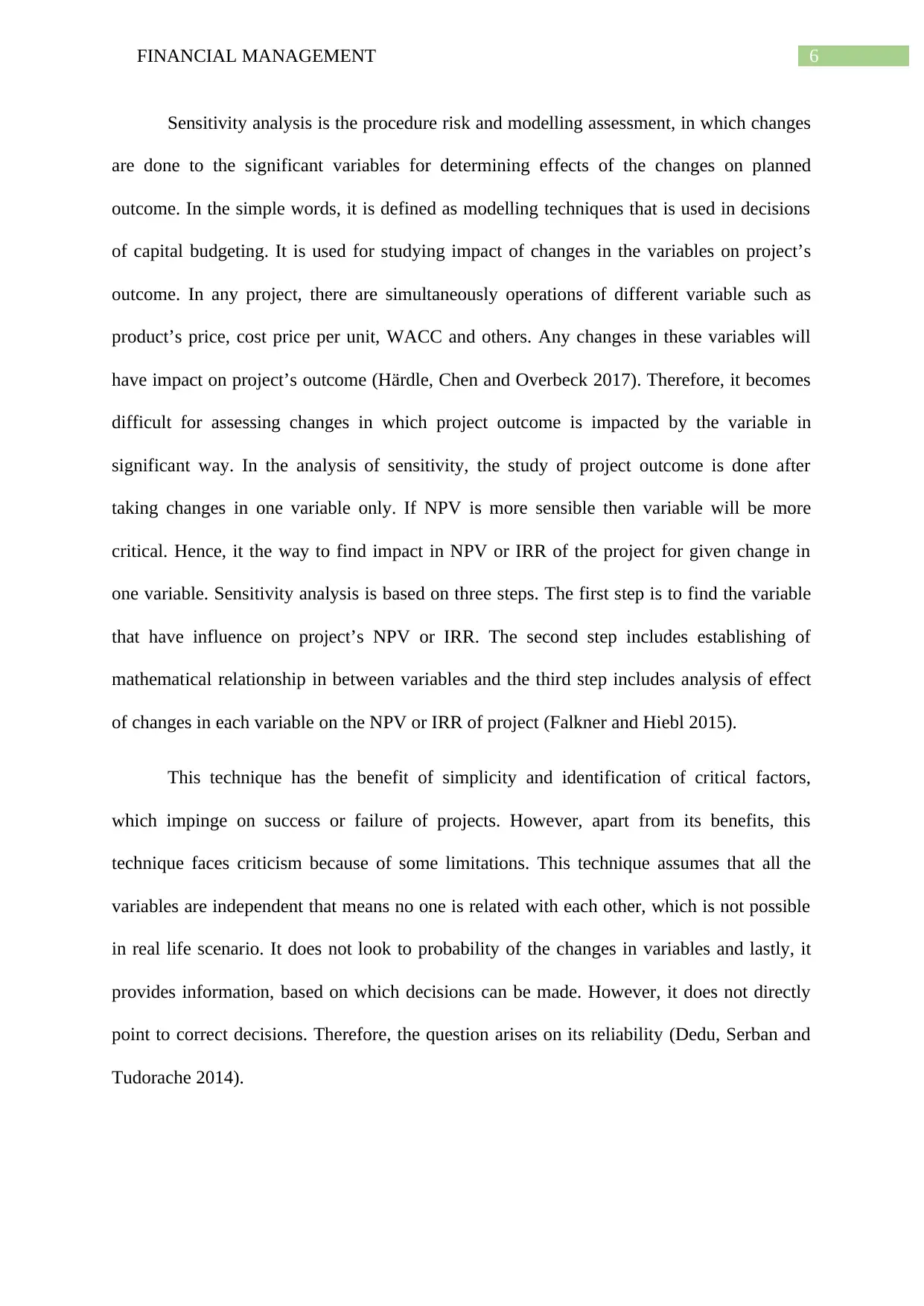
6FINANCIAL MANAGEMENT
Sensitivity analysis is the procedure risk and modelling assessment, in which changes
are done to the significant variables for determining effects of the changes on planned
outcome. In the simple words, it is defined as modelling techniques that is used in decisions
of capital budgeting. It is used for studying impact of changes in the variables on project’s
outcome. In any project, there are simultaneously operations of different variable such as
product’s price, cost price per unit, WACC and others. Any changes in these variables will
have impact on project’s outcome (Härdle, Chen and Overbeck 2017). Therefore, it becomes
difficult for assessing changes in which project outcome is impacted by the variable in
significant way. In the analysis of sensitivity, the study of project outcome is done after
taking changes in one variable only. If NPV is more sensible then variable will be more
critical. Hence, it the way to find impact in NPV or IRR of the project for given change in
one variable. Sensitivity analysis is based on three steps. The first step is to find the variable
that have influence on project’s NPV or IRR. The second step includes establishing of
mathematical relationship in between variables and the third step includes analysis of effect
of changes in each variable on the NPV or IRR of project (Falkner and Hiebl 2015).
This technique has the benefit of simplicity and identification of critical factors,
which impinge on success or failure of projects. However, apart from its benefits, this
technique faces criticism because of some limitations. This technique assumes that all the
variables are independent that means no one is related with each other, which is not possible
in real life scenario. It does not look to probability of the changes in variables and lastly, it
provides information, based on which decisions can be made. However, it does not directly
point to correct decisions. Therefore, the question arises on its reliability (Dedu, Serban and
Tudorache 2014).
Sensitivity analysis is the procedure risk and modelling assessment, in which changes
are done to the significant variables for determining effects of the changes on planned
outcome. In the simple words, it is defined as modelling techniques that is used in decisions
of capital budgeting. It is used for studying impact of changes in the variables on project’s
outcome. In any project, there are simultaneously operations of different variable such as
product’s price, cost price per unit, WACC and others. Any changes in these variables will
have impact on project’s outcome (Härdle, Chen and Overbeck 2017). Therefore, it becomes
difficult for assessing changes in which project outcome is impacted by the variable in
significant way. In the analysis of sensitivity, the study of project outcome is done after
taking changes in one variable only. If NPV is more sensible then variable will be more
critical. Hence, it the way to find impact in NPV or IRR of the project for given change in
one variable. Sensitivity analysis is based on three steps. The first step is to find the variable
that have influence on project’s NPV or IRR. The second step includes establishing of
mathematical relationship in between variables and the third step includes analysis of effect
of changes in each variable on the NPV or IRR of project (Falkner and Hiebl 2015).
This technique has the benefit of simplicity and identification of critical factors,
which impinge on success or failure of projects. However, apart from its benefits, this
technique faces criticism because of some limitations. This technique assumes that all the
variables are independent that means no one is related with each other, which is not possible
in real life scenario. It does not look to probability of the changes in variables and lastly, it
provides information, based on which decisions can be made. However, it does not directly
point to correct decisions. Therefore, the question arises on its reliability (Dedu, Serban and
Tudorache 2014).
Paraphrase This Document
Need a fresh take? Get an instant paraphrase of this document with our AI Paraphraser
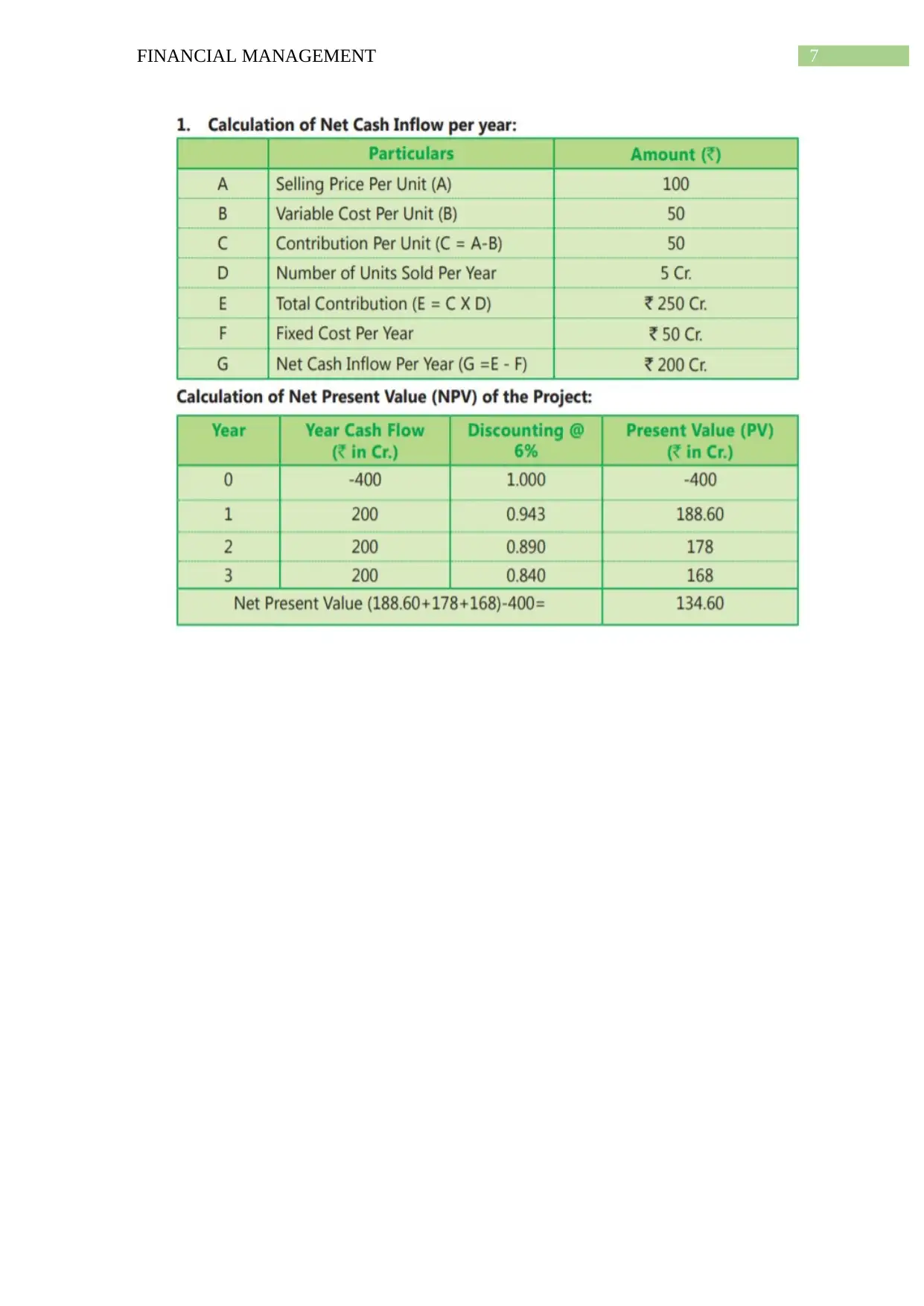
7FINANCIAL MANAGEMENT
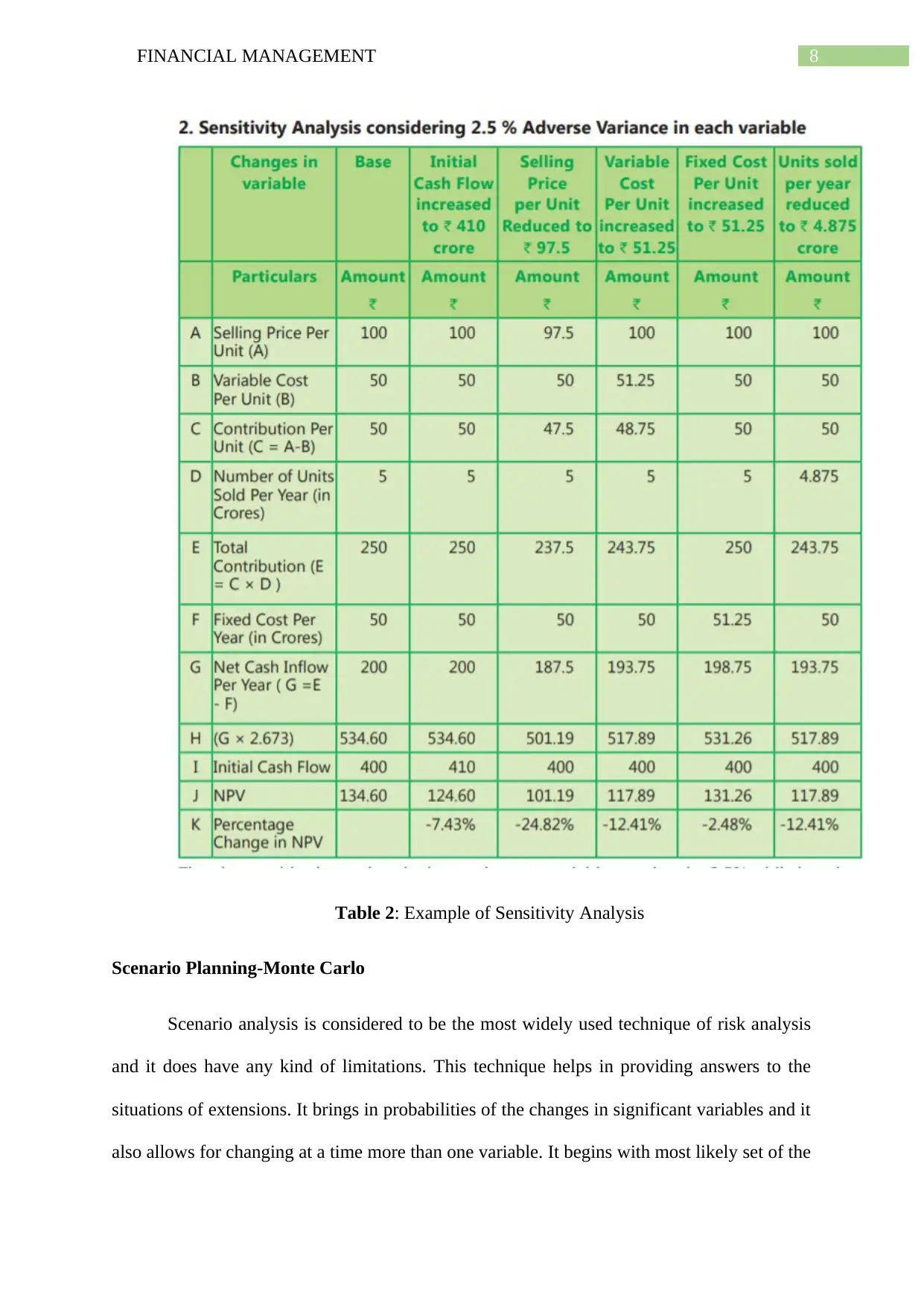
8FINANCIAL MANAGEMENT
Table 2: Example of Sensitivity Analysis
Scenario Planning-Monte Carlo
Scenario analysis is considered to be the most widely used technique of risk analysis
and it does have any kind of limitations. This technique helps in providing answers to the
situations of extensions. It brings in probabilities of the changes in significant variables and it
also allows for changing at a time more than one variable. It begins with most likely set of the
Table 2: Example of Sensitivity Analysis
Scenario Planning-Monte Carlo
Scenario analysis is considered to be the most widely used technique of risk analysis
and it does have any kind of limitations. This technique helps in providing answers to the
situations of extensions. It brings in probabilities of the changes in significant variables and it
also allows for changing at a time more than one variable. It begins with most likely set of the
⊘ This is a preview!⊘
Do you want full access?
Subscribe today to unlock all pages.

Trusted by 1+ million students worldwide
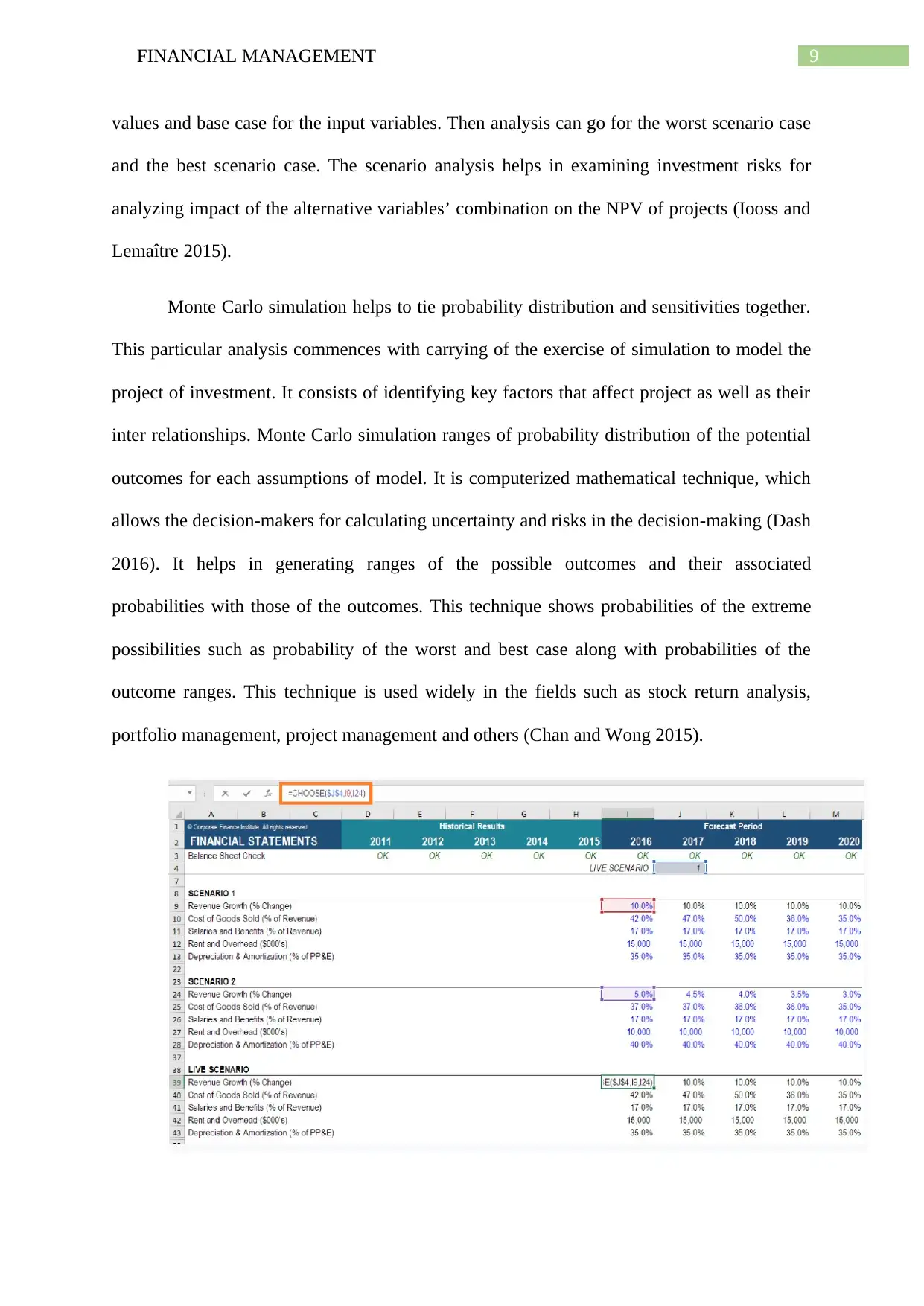
9FINANCIAL MANAGEMENT
values and base case for the input variables. Then analysis can go for the worst scenario case
and the best scenario case. The scenario analysis helps in examining investment risks for
analyzing impact of the alternative variables’ combination on the NPV of projects (Iooss and
Lemaître 2015).
Monte Carlo simulation helps to tie probability distribution and sensitivities together.
This particular analysis commences with carrying of the exercise of simulation to model the
project of investment. It consists of identifying key factors that affect project as well as their
inter relationships. Monte Carlo simulation ranges of probability distribution of the potential
outcomes for each assumptions of model. It is computerized mathematical technique, which
allows the decision-makers for calculating uncertainty and risks in the decision-making (Dash
2016). It helps in generating ranges of the possible outcomes and their associated
probabilities with those of the outcomes. This technique shows probabilities of the extreme
possibilities such as probability of the worst and best case along with probabilities of the
outcome ranges. This technique is used widely in the fields such as stock return analysis,
portfolio management, project management and others (Chan and Wong 2015).
values and base case for the input variables. Then analysis can go for the worst scenario case
and the best scenario case. The scenario analysis helps in examining investment risks for
analyzing impact of the alternative variables’ combination on the NPV of projects (Iooss and
Lemaître 2015).
Monte Carlo simulation helps to tie probability distribution and sensitivities together.
This particular analysis commences with carrying of the exercise of simulation to model the
project of investment. It consists of identifying key factors that affect project as well as their
inter relationships. Monte Carlo simulation ranges of probability distribution of the potential
outcomes for each assumptions of model. It is computerized mathematical technique, which
allows the decision-makers for calculating uncertainty and risks in the decision-making (Dash
2016). It helps in generating ranges of the possible outcomes and their associated
probabilities with those of the outcomes. This technique shows probabilities of the extreme
possibilities such as probability of the worst and best case along with probabilities of the
outcome ranges. This technique is used widely in the fields such as stock return analysis,
portfolio management, project management and others (Chan and Wong 2015).
Paraphrase This Document
Need a fresh take? Get an instant paraphrase of this document with our AI Paraphraser
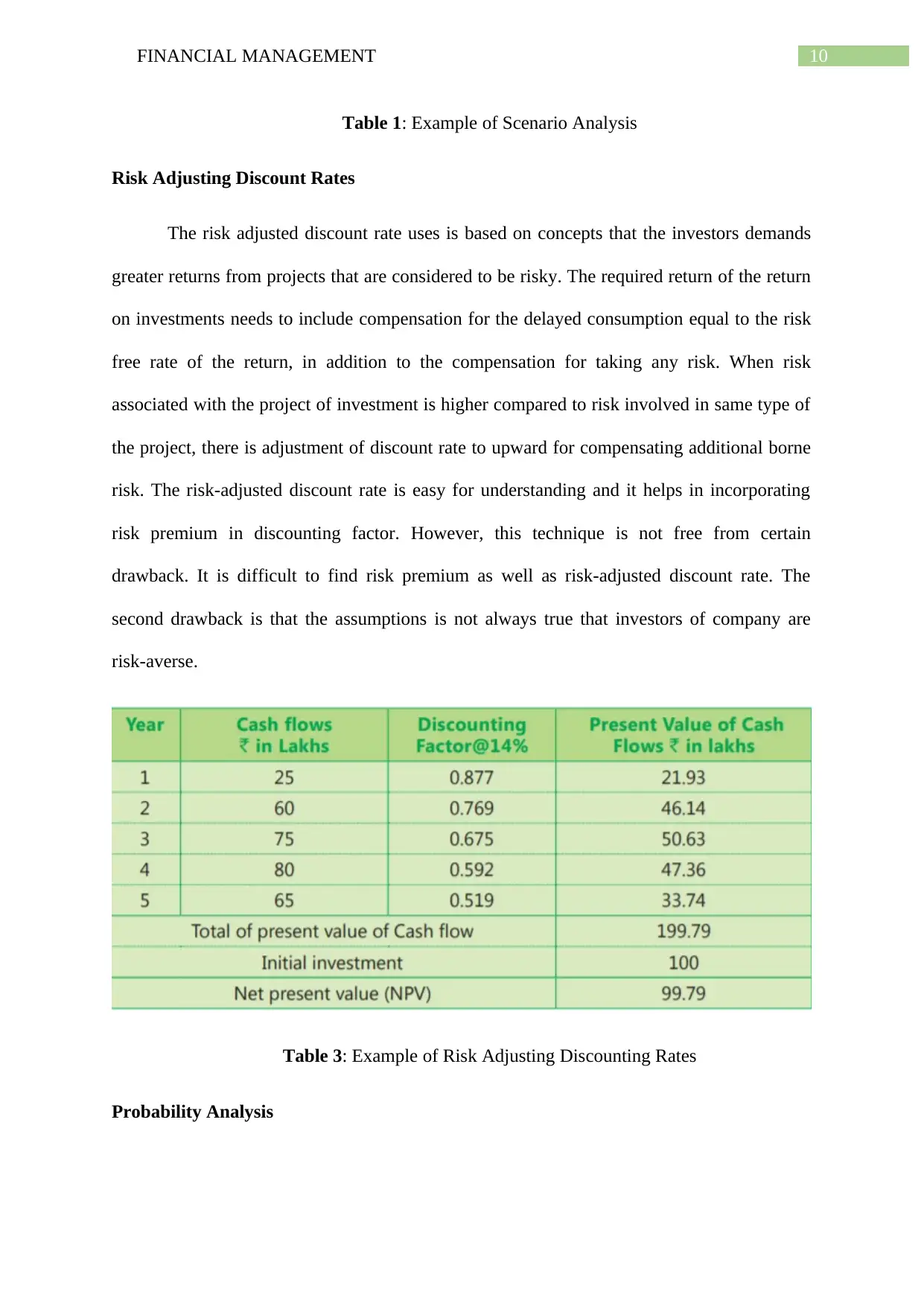
10FINANCIAL MANAGEMENT
Table 1: Example of Scenario Analysis
Risk Adjusting Discount Rates
The risk adjusted discount rate uses is based on concepts that the investors demands
greater returns from projects that are considered to be risky. The required return of the return
on investments needs to include compensation for the delayed consumption equal to the risk
free rate of the return, in addition to the compensation for taking any risk. When risk
associated with the project of investment is higher compared to risk involved in same type of
the project, there is adjustment of discount rate to upward for compensating additional borne
risk. The risk-adjusted discount rate is easy for understanding and it helps in incorporating
risk premium in discounting factor. However, this technique is not free from certain
drawback. It is difficult to find risk premium as well as risk-adjusted discount rate. The
second drawback is that the assumptions is not always true that investors of company are
risk-averse.
Table 3: Example of Risk Adjusting Discounting Rates
Probability Analysis
Table 1: Example of Scenario Analysis
Risk Adjusting Discount Rates
The risk adjusted discount rate uses is based on concepts that the investors demands
greater returns from projects that are considered to be risky. The required return of the return
on investments needs to include compensation for the delayed consumption equal to the risk
free rate of the return, in addition to the compensation for taking any risk. When risk
associated with the project of investment is higher compared to risk involved in same type of
the project, there is adjustment of discount rate to upward for compensating additional borne
risk. The risk-adjusted discount rate is easy for understanding and it helps in incorporating
risk premium in discounting factor. However, this technique is not free from certain
drawback. It is difficult to find risk premium as well as risk-adjusted discount rate. The
second drawback is that the assumptions is not always true that investors of company are
risk-averse.
Table 3: Example of Risk Adjusting Discounting Rates
Probability Analysis
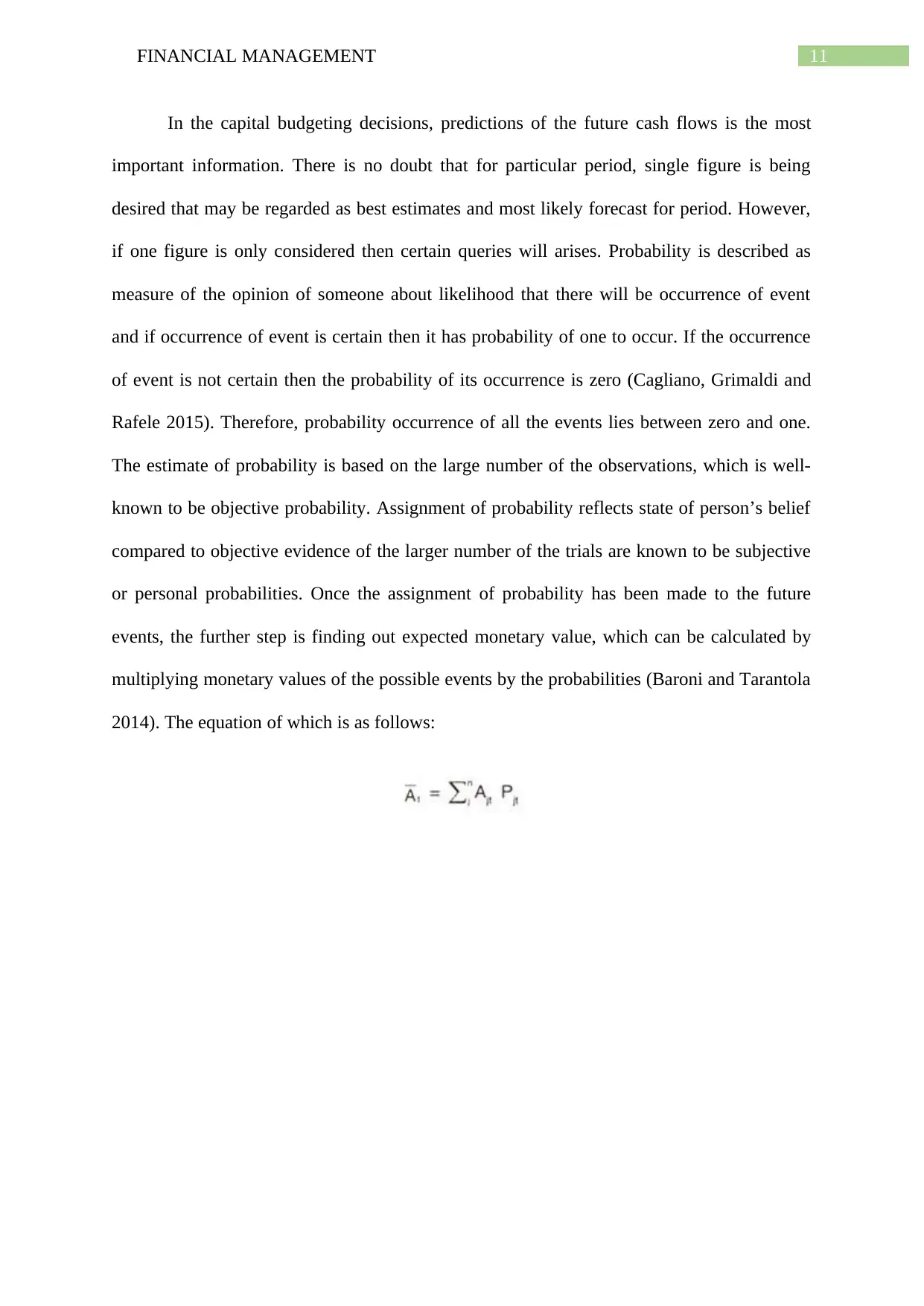
11FINANCIAL MANAGEMENT
In the capital budgeting decisions, predictions of the future cash flows is the most
important information. There is no doubt that for particular period, single figure is being
desired that may be regarded as best estimates and most likely forecast for period. However,
if one figure is only considered then certain queries will arises. Probability is described as
measure of the opinion of someone about likelihood that there will be occurrence of event
and if occurrence of event is certain then it has probability of one to occur. If the occurrence
of event is not certain then the probability of its occurrence is zero (Cagliano, Grimaldi and
Rafele 2015). Therefore, probability occurrence of all the events lies between zero and one.
The estimate of probability is based on the large number of the observations, which is well-
known to be objective probability. Assignment of probability reflects state of person’s belief
compared to objective evidence of the larger number of the trials are known to be subjective
or personal probabilities. Once the assignment of probability has been made to the future
events, the further step is finding out expected monetary value, which can be calculated by
multiplying monetary values of the possible events by the probabilities (Baroni and Tarantola
2014). The equation of which is as follows:
In the capital budgeting decisions, predictions of the future cash flows is the most
important information. There is no doubt that for particular period, single figure is being
desired that may be regarded as best estimates and most likely forecast for period. However,
if one figure is only considered then certain queries will arises. Probability is described as
measure of the opinion of someone about likelihood that there will be occurrence of event
and if occurrence of event is certain then it has probability of one to occur. If the occurrence
of event is not certain then the probability of its occurrence is zero (Cagliano, Grimaldi and
Rafele 2015). Therefore, probability occurrence of all the events lies between zero and one.
The estimate of probability is based on the large number of the observations, which is well-
known to be objective probability. Assignment of probability reflects state of person’s belief
compared to objective evidence of the larger number of the trials are known to be subjective
or personal probabilities. Once the assignment of probability has been made to the future
events, the further step is finding out expected monetary value, which can be calculated by
multiplying monetary values of the possible events by the probabilities (Baroni and Tarantola
2014). The equation of which is as follows:
⊘ This is a preview!⊘
Do you want full access?
Subscribe today to unlock all pages.

Trusted by 1+ million students worldwide
1 out of 17
Related Documents
Your All-in-One AI-Powered Toolkit for Academic Success.
+13062052269
info@desklib.com
Available 24*7 on WhatsApp / Email
![[object Object]](/_next/static/media/star-bottom.7253800d.svg)
Unlock your academic potential
Copyright © 2020–2025 A2Z Services. All Rights Reserved. Developed and managed by ZUCOL.




